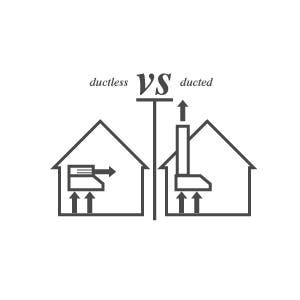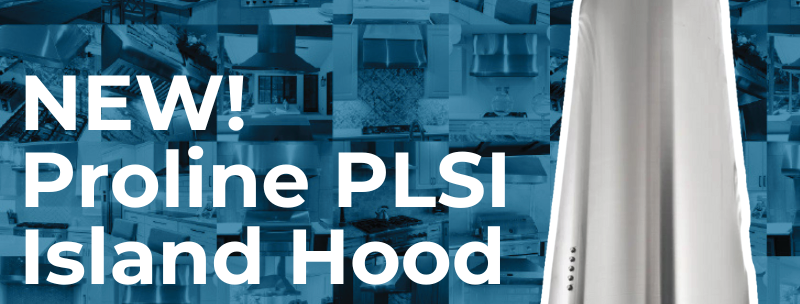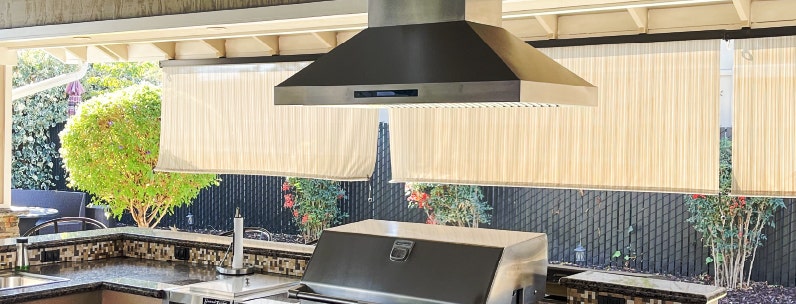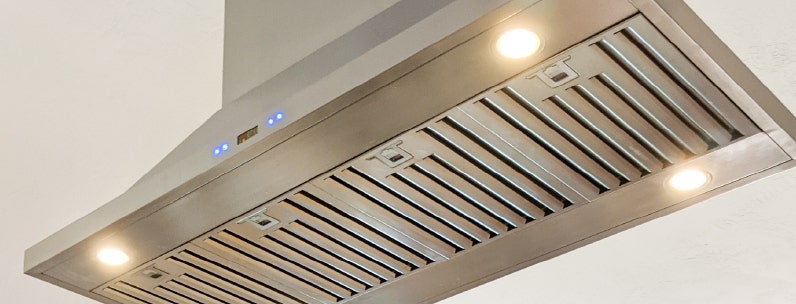The Proline Range Hood Buyer's Guide
- Why do I need a range hood?
- What should I look for when buying a range hood?
- How do I know what kind of range hood I need?
- What size range hood do I need?
- How many CFM does my range hood need to be?
- What are the benefits of a ducted verses and ductless hood?
- What else do I need to know when buying a range hood?
- Why should I buy a Proline Range Hoods kitchen fan?
- What accessories can I buy for my range hood?
Why do I need a range hood?
One important appliance that should not be overlooked when building or remodeling a kitchen is the range hood.
When you cook, the smoke, scents and particles released can damage your kitchen and even potentially be harmful to your health if there is not a proper ventilation system to help remove these elements from the air.
A range hood, sometimes also called a vent hood, will pull most of the grease and chemicals out of the room so you don’t have to worry about unhealthy smoke or unpleasant odors.
This will help the other appliances last longer as well as the grease caused and pollutants caused by cooking can deteriorate and prematurely age the materials in your kitchen. On top of that, many states are now requiring ventilation inside of your kitchen by law.
Other benefits of having a range hood in your kitchen include:
- Range hoods contribute to keeping your kitchen cleaner. Your countertops and walls will remain cleaner since smoke and grease will not be able to build up or spread.
- If your space is not properly ventilated, carbon monoxide can build up to dangerous levels. Range hoods reduce the risk of carbon monoxide poisoning.
- Range hoods play a big part in fire protection. They can help cool off hot kitchens by removing excess heat, as well as smoke and particles. The smoke is moved outside, which means the smoke detector will not be triggered while cooking.
- Most range hoods are equipped with lighting features to provide a brighter environment to your space, which aids in prep and cooking safety.
- Range hoods are required by law in many states. Having a range hood can increase your property value and be one less thing your future buyer will have to invest in.
What should I look for when buying a range hood?
The two most important factors for selecting the right range hood for your home is the size of your range and the area you would like to mount the hood. You must take into account whether you would like the range mounted under a cabinet, against a wall, above an island, or any other location in your kitchen. To determine the size you must measure your range size and read our sizing guide below.
How do I know what kind of range hood I need?
In order to determine which range hood would best suit your home, the layout of your kitchen must be considered. This is dependent upon where your cooking range is situated in your kitchen. Below are the most common mounting types for range hoods.
Under cabinet range hoods are one of the most common types of range hoods you will see. They are mounted to the underside of a cabinet situated above your range. They are often sleek in design, giving you ventilation power while blending into your kitchen and cabinet space.
Proline’s under cabinet hoods are easy to install and include dishwasher safe filters make cleaning a breeze. They are an affordable choice and usually cost less than many other types of range hoods.
These range hoods offer powerful ventilation performance while seamlessly fitting into any kitchen space. Browse our wide range of range hoods to find the perfect fit for your kitchen.
Wall Range hoods are similar in appearance to the under cabinet range hood but instead of being mounted to the cabinets above the range, they mount to the wall above. This is the perfect option for if there are no cabinets above your range, and your cooktop is situated against a wall.
Wall range hoods are wider along the bottom, spanning the length of the stove, but then narrow toward the vent. This type of range hood mounting style is the obvious choice when there is no cabinet set above your range.
No matter what height your ceiling is, chimney extensions are available in various heights to make sure your wall range hood is able to properly ventilate.
Island range hoods are the best way to ventilate your kitchen if you have an island cooktop. These are mounted to and vented through ductwork in the ceiling above your island.
With a lack of a wall or cabinets alongside them to help funnel fumes, island range hoods should generally be sized be wider than the cooking surface. We recommend 3"-6" of additional space on each side.
Proline offers elegant stainless steel and glass island vent hoods in all sizes.
Proline Range Hoods offers professional range hoods in a wide variety of sizes and styles with additional CFM power to fit the need of the busiest of kitchens and most demanding chefs.
Proline's professional grade range hoods generally have a higher CFM to help kitchens that handle large amounts of smoke, grease, or other pollutants.
With up to 2000 CFM our easy to install and easy to clean range hoods offer the ventilation power needed to keep up with your kitchen's ventilation and air filtration needs.
Our variety of professional range hood styles include wall mounted range hoods, island range hoods, under cabinet range hoods, or range hood inserts.
Outdoor range hoods help keep your grill or outdoor kitchen free from smoke, grease, or other cooking byproducts.
These range hoods are stronger than normal because they need to be able to handle the elements of the outdoors and are usually set up to sit above the average height from the range.
Since in an outdoor space there are wind and other elements present, it is best to purchase an outdoor range hood that is two sizes larger than your cooktop (6"-12" overlapping on each side).
Range hood inserts are the ventilation unit that fits within an existing custom made range hood or cabinet.
They provide the main functionality of range hoods and are a more adaptable option for specific designs.
Inserts are great for flexibility and come in a wide array of sizes and CFM power to fit any custom hood.
What size range hood do I need?

For most cooking situations, the size of the hood should be directly related to the surface area of your cooktop. Proline recommends that the width of your range hood is as wide or a size wider than your range width.
For indoor kitchens we recommend purchasing a range hood that is one size larger than your range size.
This means that it overlaps the size of your range by 3” to 6” on each size.
For example if your stovetop size is 30” we recommend purchasing a range hood that is 36”.
For outdoor kitchens we recommend purchasing a hood that is two sizes larger (overlapping by 6” to 12” on each side) than your cooktop to account for the potential wind and other factors that come with cooking in outdoor spaces.
For example if your outdoor kitchen cooktop is 30” the ideal range hood size is between 42” and 54”.
Before purchasing a range hood make sure you measure the space where you plan to put it so you know your size requirements and limitations.
How many CFM does my range hood need to be?
Calculating How Many CFM’s You Need
The more powerful your range hood, the more effective it will be at removing air from the cooking space. The power of air movement for range hoods is measured in CFM (cubic feet per minute).
Generally, the rule for a GAS cooktop is, for every 10,000 BTU your gas stove generates you will need 100 CFM. Example 60,000 BTU's = 600 CFM.
For an ELECTRIC stove, the CFM is estimated according to the size of the stove. You need 100 CFM for every 10" of stove width, so if your stove/cooktop is 36" then you will need at least 360 CFM.
There are some factors that may lead you to want to have a range hood with a higher CFM.
When you cook, if there is routinely a lot of smoke, grease, or other fumes a range hood with higher CFM will ensure that all of the cooking byproducts are able to be removed from the kitchen area.
If your range hood is situated on an island, a range hood with higher CFM is recommended since there is no wall or backdrop near the cooking area to funnel the smoke and air.
Lastly, if you are installing a range hood for a grill or outdoor kitchen a higher CFM hood is highly recommended. This is due to the fact that outdoor spaces are exposed to wind and other elements that affect how the air flows.
What are the benefits of a ducted verses and ductless hood?

The ventilation type dictates where the air removed by the range hood is going to ultimately end up. There are three options for hoods:
Ducted or Vented
Ducted hoods completely remove the irritants from your kitchen and home. This type of ventilation is always preferred. If you can, duct the hood to the outside of your home.
If your range hood mounts to an exterior wall, the exhaust ducts will be shorter and thus more efficient. If your range hood mounts to an interior wall or island, there is a larger distance the air must travel in order to escape so a more powerful unit should be considered.
Proper installation of ductwork is critical to the efficiency and overall performance of the range hood. Ductwork can be run through an attic to the outdoors but should never vent into an attic or basement.
Make sure the size of the duct is the same as the duct attachment at the hood.
Recirculated or Non-Vented or Ductless
Ductless range hoods are used when running ducting to get the exhaust air outside the home is not a viable option. In this method, a recirculating range hood or a recirculating kit can be added to a regular ducted hood. With this additional filter installed, usually, a carbon or charcoal filter, the air is cleaned and reintroduced it back into the kitchen or cooking area.
This obviously isn't the best way to clear the air but works well if fully extracting the air isn't an option. It's important to replace recirculating filters every few months to ensure the hood performs well.
Convertible
These are hoods that can be converted to either ducted or recirculated. For the best ventilation results, duct to the outside. Double check before purchasing a convertible range hood to make sure you don't need additional parts to make it recirculating.
What else do I need to know when buying a range hood?
Cost
Proline offers lower prices than many competitors because we are the manufacturer, while other competitors are just distributors in a chain of distributors that increase costs every step of the way.
We have different range hoods that will fit your budget.
Look
The cooking area is one of the main focal points of the kitchen. Your range hood should compliment the look and feel of your kitchen.
Proline offers popular range hood styles in both stainless steel and glass design to help you match the kitchen aesthetic you desire.
We also offer our line of Artisan range hoods and inserts for your custom hood needs. If you are looking for a modern and industrial look we offer our line of Iron Craftsman hoods. We also offer our Victorian line of hoods for kitchens with a more rustic and elegant appearance.
What Is A Good Sone Rating For A Range Hood?Noise Level
The sound that a range hood makes is measured in sones. One sone is roughly equal to the sound of a refrigerator running. Normal conversations take place at about 4 sones and light traffic rates up to around 8.
Proline’s range hoods are all within 2-7 sones. Keep in mind that the higher CFM (ventilation power) a range hood has, and the faster the speed you run it on, the more noise it will produce. Also, if the CFMs are equal, the larger the hood, the quieter it will be. Imagine moving the same amount of air through a larger space produces less friction and noise.
Ease of Installation
An important aspect of selecting the right range hood is the ease of installation. Whether you are a DIY’er or are going to hire someone to get the job done, the easier the installation process the more money you will end up saving in the long run. Proline's hoods are very simple to install.
View Proline’s Installation Guide to see how a typical Proline range hood is installed.
Maintenance
All range hoods require some maintenance and cleaning to maintain optimal performance. They require cleaning of grease traps and fans because grease will build up over time. Proline’s baffle filters are dishwasher safe to make cleaning a breeze.
To maximize airflow, it is best to routinely clean all parts that are susceptible to grease. This will help keep your range hood working effectively for years to come. You can find a number of videos on care and maintenance of your hood HERE and see how easy it is to keep your hood in good working order for years to come.
Why should I buy a Proline Range Hoods kitchen fan?
Timer
Most range hoods that come with control panels have screens and a timer set up to turn off after you are done cooking. This allows you to run the range hood for just as long as you’re planning on cooking without the risk of forgetting to turn it off. It also lets you keep it running for another 5 or 10 minutes when you are done cooking to make sure the air is clear.
Lights
Most of the range hoods you consider will come with lights, so consider what type and how bright they are. The right lights enable higher visibility for the chef.
Proline offers range hoods with the option of LED or Halogen lighting, both of which are highly energy efficient.
Filter Options
Proline offers two types of filters for the range hoods, Baffle and charcoal filters. Baffle filters are in most of our range hoods and are dishwasher safe to ease the cleaning process.
These filters employ an advanced design that is made to efficiently trap grease, moisture and harmful substances even before it is expelled to the outside.
Charcoal filters are used in ductless range hoods to remove contaminants.
Charcoal filters cannot be washed or cleaned, and should be replaced every few months (depending on the amount of cooking).
Variable fan speed
Variable fan speed allows you to adjust the range hood power depending on what type of cooking you are engaging in.
Whether you are expecting a large amount of smoke or grease or a minimal amount, you can adjust the fan speed to accommodate for the various situations.
Many of Proline’s range hoods are equipped with at least 4 fan speeds.
What accessories can I buy for my range hood?
Do I need a chimney extension? (Infographic)
Chimney extension
Depending on the layout of your kitchen, a chimney extension may be required for your kitchen ceiling's height. Extension needs vary by ceiling height and hood type. If you have a particularly short or high ceiling, these extensions allow for a customized fit. They hide the actual ductwork that carries the air outside.
Blowers
A Local Blower is a blower installed directly inside the range hood body. Proline's range hoods come with a local blower already installed.
A Remote Blower or Inline Blower is not in the range hood itself but is installed in the ductwork between the range hood and your roof. One benefit of this type of blower is that it is the quieter to operate because the fan is located away from the kitchen. This may be even more beneficial if you are purchasing a smaller range hood with a high CFM.
Here are some additional considerations for you before purchasing your new range hood.










